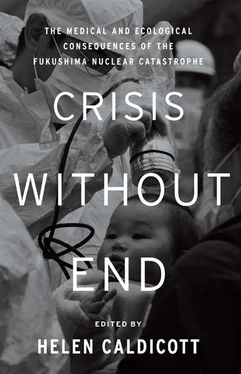As I noted at the outset, risk assessment uses figures drawn from studies such as the LSS and dose estimates for populations to estimate radiation casualties in populations whose disease incidence has not been quantified. Biases in radiation effects such as those in the LSS affect risk estimation. In contrast, epidemiologic studies such as the LSS directly estimate relationships between radiation and disease; however, they can only evaluate effects after they have occurred.
I started working on radiation epidemiology in 1988 when I was assigned to lead a study of the mortality of workers employed at one of the first nuclear weapons plants, the Oak Ridge National Laboratory in eastern Tennessee. The workers’ radiation doses had been monitored from very early on with individual dosimeters. I was told that we would not find any radiation effects in this population because the doses were too low, so my first clash with the dominant wisdom in this field was when we did see dose–response relationships: the higher the readings on the badges, the higher the cancer death rates of the workers. I had been told this was impossible, and yet there it was.
The disaster at Chornobyl was followed by similarly dismissive rhetoric regarding risk estimates. In a 1991 document, five years after the explosion of the Chornobyl reactor, the International Atomic Energy Agency stated: “On the basis of the doses estimated by the project teams and currently accepted radiation risk estimates, future increases over the natural incidence of cancers or hereditary effects would be difficult to discern even with large and well-designed long term epidemiological studies.” Since that time a large number of epidemiologic studies have documented increases in cancer from Chornobyl’s radiation releases. As in the Oak Ridge study, this prediction was made based on a risk assessment that used assumptions from the LSS.
Another nuclear event where we were told that there were no cancer effects possible was the partial meltdown of the Three Mile Island Unit 2 reactor in 1979. Many people who lived close to the plant reported symptoms such as reddening of the skin, nausea, vomiting, and hair loss, as well as the deaths of pets and animals. Those people were told that their symptoms were due to stress.
I started working on this issue because of a lawsuit that involved several thousand people. I first looked into stress, but my assessment of the medical literature was that the reports did not fit the scenario of stress-induced acute effects, sometimes called “mass psychogenic illness.” We conducted a reanalysis of data from a prior study of cancer patients seen at area hospitals during the period 1975 to 1985 and found that the incidence of lung cancer and leukemia rose in the pathways of plumes of radioactive gases released during the meltdown. The study was designed to avoid detection bias, which is a major concern when studying a well-publicized event because people report disease earlier and receive more diagnostic tests due to publicity. Everyone in this study was within ten miles of the accident, however, and they were all exposed to the same detection bias.
Official estimates of the health impacts of routine releases of radiation from nuclear power plants project that no cancers will be observed among people who live near operating reactors. However, several studies conducted in Europe have found excess childhood cancer, and particularly leukemia among children aged 0–4, near power reactors. The largest, a German case-control study, showed that leukemia incidence more than doubled within five kilometers of power plants. The authors, however, concluded that “radiation exposure near German nuclear power plants is a factor of 1,000 to 100,000 less than annual average exposure from medical exams, therefore the observed positive distance trend remains unexplained.”
These examples show how epidemiologic studies can produce evidence of radiation impacts that is not anticipated from risk assessments. There are three possible reasons for this. One possibility is that the epidemiologic studies are biased. However, the biases in environmental and occupational epidemiology, most prominently poor exposure measurement, migration, and, in occupational studies, healthy worker effects, tend to cause under- rather than overestimation of radiation effects. A second reason why risk assessments may not agree with epidemiologic studies is that they use radiation risk estimates, such as those from the LSS, that are too low. A third reason is that there are seldom any direct measurements of human doses, especially for environmental radiation, and risk assessments will produce underestimates of disease if people are exposed to more radiation than assumed.
Energy generation is highly profitable, and nuclear power is tied to governments and corporations that created the nuclear weapons and power industries in the first place. This creates financial conflicts of interest in studies of radiation and health, especially when evidence of health effects could increase pressures to reduce radiation exposures to workers and the public, and when there could be lawsuits from exposed people who seek compensation. For example, government documents reviewed in the 1990s by the U.S. president’s Advisory Committee on Human Radiation Experimentation clearly showed that fear of lawsuits and public opposition to the nuclear weapons program were important considerations in the deliberations of the Atomic Energy Commission’s Advisory Committee on Biology and Medicine. Because our science is affected by our political system, we need public education, not only about radiation, but about science and about civic life.
In Fukushima, there will be extra challenges to epidemiological studies. Some of those challenges involve the fact that the earthquake and tsunami that triggered the meltdowns severely disrupted living conditions. People were relocating, their diets were affected, medical services were affected, and many thousands died. Estimating doses for individuals, which is critical in epidemiological studies and always difficult where people are not monitored for radiation exposure, is even more uncertain in the situation of such a disaster.
Radiation-exposed populations and the general public should know that research is imperfect. The scientific community must also understand that the main threat to research is a lack of critical thinking, which includes self-critical thinking. We must question authority, and especially studies that, like the LSS, are applied every day to legal and public health situations. However, it is equally important not to confuse narrowly constructed research hypotheses about the health effects of particular exposures with sweeping analyses of systemic issues of great interest, such as whether nuclear power is good public policy. Even if nuclear power is bad policy, that does not mean every study will find that radiation is associated with disease.
Public health activists promote policies based on broad principles such as peace, human rights, ecological sustainability, and social justice that promote health and prevent disease through diverse physical, biological, and social mechanisms. Although rooted in theory and evidence from many scientific disciplines, such principles are not hypotheses subject to refutation by specific studies; rather they are evolving world-views that integrate science, morality, and politics. Because of their global orientation, public health advocates may ignore or reject studies that do not appear to support their movement’s goals, such as research that fails to demonstrate disease excesses among people exposed to radiation. Likewise, advocates may uncritically accept research that finds disease to be associated with radiation. This double standard undermines both science and public health by overemphasizing the importance of narrow research questions and by neglecting weaknesses of specific health studies. Because exposure assessments and epidemiologic studies can be easily designed to be insensitive to effects under investigation, they are most politically useful to industries and governments that are responsible for exposing workers and the general public. Therefore overemphasizing this type of research is not in the public interest. By discriminating between the results of narrow studies and broad policy goals, activists can better advance both science and public health.
Читать дальше












![Helen Rowland - The Widow [To Say Nothing of the Man]](/books/752764/helen-rowland-the-widow-to-say-nothing-of-the-man-thumb.webp)